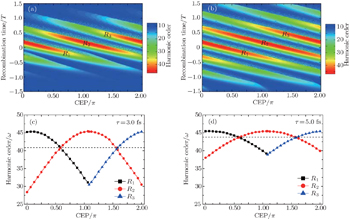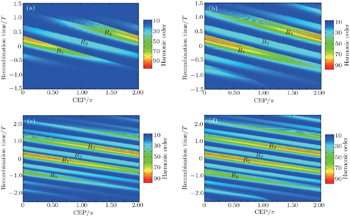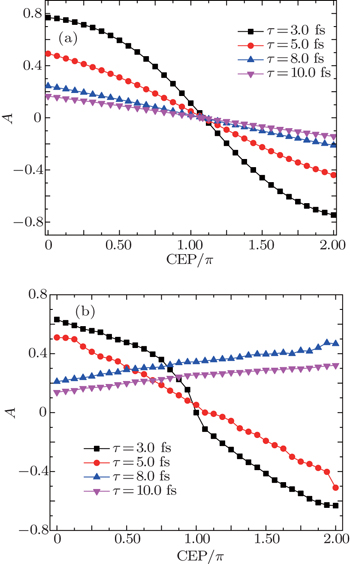† Corresponding author. E-mail:
Project supported by the National Natural Science Foundation of China (Grant Nos. 11264036, 11364038, and 11465016).
We investigate the plasmonic-field-enhanced high-order harmonic generation (HHG) of H atom driven by few-cycle laser pulses, by solving the time-dependent Schrödinger equation (TDSE). Compared with the homogeneous field, HHG spectra generated by inhomogeneous field exhibit two-plateau structure. We analyze the origin of the two plateaus by using the semiclassical trajectory method. Our results from both classical and TDSE simulations show that the cutoffs of the two plateaus are dramatically affected by the carrier-envelope phase (CEP) of laser pulse in the inhomogeneous field, even for a little longer pulse. Thus, we can determine the CEP of driving laser based on the cutoff position of HHG generated in the inhomogeneous field.
High-order harmonics are generated when the matter is subject to a short, intense laser field.[1] Since the high-order harmonic spectra can be extended to the soft x-ray region[2,3] and exhibit a supercontinuous structure, it becomes a preferred light source for the generation of attosecond pulses.[4,5] Generally, the high harmonic generation (HHG) can be well understood by the semiclassical three-step model.[6,7] According to this model, the electron is first ionized toward continuum by tunneling through the field-modified potential barrier, then accelerated in the laser field, and finally recombined with the parent ion and emits a harmonic photon. The highest harmonic energy (cutoff) is given by the formula Ip + 3.17Up, where Ip is the atomic ionization potential and Up is the ponderomotive potential. Recently, the studies of plasmonic-field-enhanced HHG have demonstrated that the inhomogeneous field could considerably broaden the plateau region of HHG.[8–16]
With the development of laser technology, an intense laser pulse that contains only a few cycles can be generated now.[17–19] For a few-cycle laser pulse, the carrier-envelope phase (CEP) plays important roles in attosecond physics,[20,21] HHG,[22] above threshold ionization (ATI),[23,24] double ionization,[25,26] and so on. Hence, the measurement of the CEP is essentially crucial for laser–matter interaction. Jones et al.[27 confirmed the control of the pulse-to-pulse CEP using temporal cross correlation, based on the f-to-2f scheme.[27–30] However, the f-to-2f interferometer could not measure the absolute phase. Therefore, a variety of methods of measuring the CEP were raised. The determination of CEP using ATI spectrum has been demonstrated both experimentally[31–34] and theoretically.[35,36] Compared to ATI, the HHG spectrum is an all-optical method in which its signal can be more easily collected, and strong dependence of harmonic cutoff on the CEP[37,38] suggests that the retrieving of CEP from HHG spectrum is feasible. Li et al.[39] and Xiang et al.[40] have proposed two methods to measure the CEP using the HHG spectrum from asymmetric molecules. Fetić et al.[41] investigated the CEP-dependent plasmonic-field-enhanced HHG yield by using the semiclassical method. As far as we know, for the atom in the inhomogeneous field, there are no reports about the dependence of the cutoff of the HHG spectra on the CEP from the simulations by solving the time-dependent Schrödinger equation (TDSE). Thus, it is necessary to confirm the relationship between the HHG spectra and the CEP of the laser pulse by the TDSE, which will be done in this work. Based on the comparison of cutoff dependence on the CEP of laser pulse from TDSE and semiclassical simulations, we will demonstrate the possibility of measuring CEP from plasmonic-field-enhanced atomic HHG.
In Section 2, we briefly present the theory and method. In Section 3, the numerical results and analysis are presented. Finally, our conclusions are given in Section 4. The atomic units (a.u., ℏ = me = e = 4πε0 = 1) are used throughout, unless otherwise stated.
In order to obtain the HHG spectrum driven by spatial inhomogeneous field, we solve the one-dimension time-dependent Schrödinger equation (1D TDSE)



In Eq. (


In our simulations, the intensity and wavelength of the incident laser is 3.0 × 1014 W/cm2 and 800 nm, respectively. The inhomogeneity parameter is taken to be β = 0.005. We consider four different pulse durations of laser field: 3 fs, 5 fs, 8 fs, and 10 fs.
We first simulate the HHG spectra in both homogeneous field (β = 0.0) and inhomogeneous field (β = 0.005) for a CEP of ϕ = 0.0π. In Fig.
 | Fig. 1. The HHG spectra in (a) homogeneous field (β = 0.0) and (b) inhomogeneous field (β = 0.005) for pulse durations of 3 fs, 5 fs, 8 fs, and 10 fs with CEPs of 0.0π. |
In order to study the underlying mechanism of the cutoff extension and two-plateau of HHG spectra, we perform the classical trajectory simulation by solving the Newton equation. The acceleration of electron in the inhomogeneous field E(x,t) can be written as

Under the initial condition that the electron velocity ionized at the time ti from the nucleus v(ti) = 0, and the electron recombines at the recombination tr under x(tr) = 0, we can obtain the kinetic energy of electron, Ek(tr) = v2(tr)/2. Then, the photon energy of emitted harmonic is Ip + Ek(tr). Figure
Next, we investigate the CEP dependence of the cutoffs of HHG both in the homogenous and inhomogeneous fields for different pulse durations. In Fig.
 | Fig. 4. Classical harmonic order as a function of the recombination time of the electron and the CEP of the homogeneous laser pulse. (a), (c) τ = 3.0 fs; (b), (d) τ = 5.0 fs. |
Then, we study the influence of the CEP on HHG generated in inhomogeneous fields. Figure
 | Fig. 5. Recombination time of harmonic cutoff as a function of the CEP of the inhomogeneous laser field with pulse durations of (a) 3.0 fs, (b) 5.0 fs, (c) 8.0 fs, and (d) 10.0 fs. |
To compare the results shown in Fig.
 | Fig. 6. Harmonic order as a function of the CEP of the laser pulse for the classical simulation in the inhomogeneous filed β = 0.005: (a) τ = 3.0 fs, (b) τ = 5.0 fs, (c) τ = 8.0 fs, (d) τ = 10.0 fs. |
Finally, in order to determine the CEP of the driving laser pulse conveniently, we define a parameter A to describe the dependence of harmonic cutoff on the CEP value of the laser pulse, which is written as

In conclusion, we have investigated the CEP control of the plasmonic-field-enhanced HHG of H atom by solving the TDSE numerically and the semiclassical simulation. We find that there are two plateaus of the HHG spectra in the inhomogeneous field. By means of the semiclassical simulation, we explain the origin of these phenomena. The results of the semiclassical simulation are in good agreement with the TDSE results. For the longer laser pulses τ = 8.0 fs and τ = 10.0 fs, the third plateau bursts into the HHG spectrum at ϕ = 1.375π. For ϕ > 1.375π, the cutoff position of the third plateau increases in the range of 1.375π to 2.0π. Contrary to the dependence of the HHG cutoff on the CEP with a period of π in homogeneous field, the HHG spectrum depends on the CEP modulo 2.0π in the inhomogeneous field. The position of the cutoff of the HHG spectrum are dramatically affected by the CEP for the inhomogeneous field even in a little longer pulse. Moreover, the results for the first and the second cutoff of the HHG spectra with the CEP obtained from both semiclassical and the TDSE method have the same behavious in the case of short pulse. However, for the longer pulses τ = 8.0 fs and τ = 10.0 fs, the results of the TDSE are different from the semiclassical simulation. The TDSE results show that the cutoff positions of the first and second plateau decrease monotonously with the increase of CEP. As a result, the CEP of the laser pulse can be controlled effectively by the plasmonic-field-enhanced HHG spectrum, which provides a useful method for measuring the CEP of few-cycle laser pulses.
| 1 | |
| 2 | |
| 3 | |
| 4 | |
| 5 | |
| 6 | |
| 7 | |
| 8 | |
| 9 | |
| 10 | |
| 11 | |
| 12 | |
| 13 | |
| 14 | |
| 15 | |
| 16 | |
| 17 | |
| 18 | |
| 19 | |
| 20 | |
| 21 | |
| 22 | |
| 23 | |
| 24 | |
| 25 | |
| 26 | |
| 27 | |
| 28 | |
| 29 | |
| 30 | |
| 31 | |
| 32 | |
| 33 | |
| 34 | |
| 35 | |
| 36 | |
| 37 | |
| 38 | |
| 39 | |
| 40 | |
| 41 | |
| 42 | |
| 43 | |
| 44 | |
| 45 |






